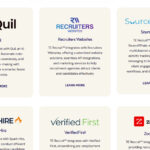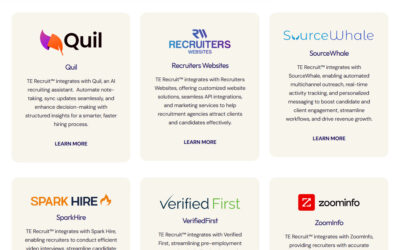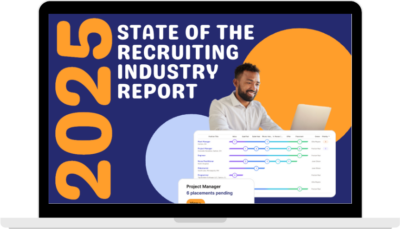Recruiting agencies and search consultants live in one of the most competitive industries in the world. Every requisition feels like a race against time. Every client wants their role filled yesterday. And every candidate—especially the good ones—has options. In this environment, the challenge is rarely finding people who need jobs. The real challenge is convincing passive candidates—the professionals who are already employed, comfortable, and not actively looking—to take your call, open your email, and seriously consider making a move.
The reality is clear: if you’re only chasing active job seekers, you’re missing the majority of the market. Industry data consistently shows that only a small fraction of the workforce is actively applying to jobs at any given moment. The rest are passive. They’re not scanning job boards. They’re not polishing their resumes. But many of them are quietly dissatisfied, wondering if there’s something better out there. They’re waiting for the right recruiter to guide them toward an opportunity they can’t ignore.
This is where your role as a search consultant becomes transformative. When you learn how to turn passive candidates into active job seekers, you move from being a transactional recruiter to being a trusted career guide. You stop competing only for the 15% of the market that’s actively looking, and instead you open the door to the hidden 85% where the best talent usually resides.
The Problem: Passive Candidates Don’t Think They’re Looking
Most recruiters already know how difficult it is to get a response from a passive candidate. You send an email. You leave a voicemail. You send a LinkedIn InMail. Silence. Days later, maybe you get a polite “thanks, but I’m not looking.” That’s where many recruiters stop. But if you accept their “I’m not looking” at face value, you’re leaving opportunities—and revenue—on the table.
Passive candidates resist because they don’t yet see themselves as job seekers. They’re busy with their current role. They might like their manager. They might fear change. And they almost always assume that the recruiter reaching out only cares about filling a job, not about what’s truly important in their career.
This is the central problem: passive candidates don’t respond because they don’t yet see what’s in it for them.
The Stakes: Why This Matters More Than Ever
The stakes in today’s recruiting environment couldn’t be higher. Clients expect speed, precision, and top-tier talent. They don’t want the candidate who happens to be available; they want the candidate who is exceptional. And the exceptional ones are usually not applying—they’re already employed.
If you don’t master the art of turning passive candidates into active ones, you risk:
-
Submitting weaker candidates who don’t excite clients.
-
Losing placements to competitors who tapped into the hidden market.
-
Eroding trust with clients when you can’t deliver the talent they need.
But when you do learn how to move passive candidates, the results are transformative:
-
You become the recruiter who delivers talent others can’t find.
-
You deepen relationships with clients who see you as a true partner.
-
You increase placements, revenue, and repeat business.
The stakes are nothing less than your reputation, your revenue, and your agency’s long-term growth.
The Guide: A Recruiter Who Understands the Candidate’s Journey
Passive candidates don’t want to be pitched jobs. They want to be understood. They want to feel like someone is listening. They want to know that making a move won’t just fill your requisition—it will advance their career, make their life easier, or bring them closer to their personal goals.
As a recruiter, your role isn’t to hard sell. Your role is to guide.
That means shifting the focus of every interaction away from “I have a job to fill” and toward “I want to understand what matters most to you.” This shift requires one core skill: active listening.
When you listen—truly listen—you uncover what candidates may not even be saying out loud. You learn what frustrates them in their current role. You discover what would motivate them to take a call, schedule an interview, or even resign from their company. You stop being just another recruiter in their inbox and become someone they trust with their career.
The Plan: Turning Passive Interest Into Active Engagement
So how do you move from passive silence to active engagement? It’s not about magic words or clever subject lines. It’s about following a repeatable plan that consistently shows candidates what’s in it for them.
Step 1: Lead With Curiosity, Not the Job
When you first reach out, don’t pitch a position. Instead, invite a conversation. A simple message like, “I’d love to learn about your career goals and what would make the next step worthwhile for you” is far more effective than a list of job duties.
Passive candidates don’t want to feel like they’re being sold to. They want to feel like they’re being heard.
Step 2: Conduct Exploratory Interviews
Once you have their attention, resist the urge to talk about the open requisition. Instead, ask broad questions:
-
“What do you enjoy most about your current role?”
-
“What would you change if you were your boss?”
-
“What must be true for you to make a change today?”
These questions uncover both frustrations and motivators. They turn the abstract idea of “someday I might move” into specific criteria that you can match to your opportunities.
Step 3: Reframe the Opportunity Around Their Goals
When you finally present a role, position it in the language they used. If they said career advancement is a priority, show how your client offers a clear path. If flexibility was top of mind, highlight hybrid or remote policies. This isn’t manipulation; it’s alignment. You’re connecting what they told you matters with what your opportunity offers.
Step 4: Maintain Engagement Throughout the Process
Turning a passive candidate into an active one isn’t a one-time event. It’s a process. Stay in touch. Provide updates, even when there’s no news. Share insights about the market. Send interview prep resources. Every touchpoint reinforces that you’re invested in them—not just the placement.
Step 5: Protect Against Counteroffers
Passive candidates are the most likely to receive counteroffers because they weren’t actively planning to leave. By asking early questions about what money can’t fix—such as leadership, culture, or growth—you can remind them why they were open to change in the first place.
The Success: What Happens When Recruiters Master This Skill
Recruiters who consistently turn passive candidates into active ones see a dramatic difference in their results. They no longer rely solely on job postings or active seekers. Instead, they unlock the hidden market of talent that competitors struggle to reach.
Success looks like:
-
Clients impressed by the caliber of talent you present.
-
Candidates who feel grateful, not pressured, because you listened and delivered.
-
A reputation as the recruiter who finds the “impossible” candidates.
-
Increased revenue and placements that fuel agency growth.
Most importantly, success looks like long-term relationships—with both clients and candidates—that pay dividends for years to come.
The Failure: What Happens If You Don’t Change
The flip side is just as important. Recruiters who continue to rely only on job postings and active seekers risk being left behind.
Failure looks like:
-
Candidate pipelines drying up because job boards no longer deliver.
-
Losing top clients to competitors who present stronger talent.
-
Constantly scrambling to fill roles with candidates who are “good enough” rather than great.
-
Burnout from chasing the same small pool of active seekers.
In a market where speed and quality matter more than ever, recruiters who don’t adapt will lose ground fast.
Why Technology Matters: Scaling the Process
Turning passive candidates into active ones requires time and consistency. But let’s be honest: most recruiters already feel stretched thin. Between sourcing, scheduling, interviewing, and reporting, it’s easy to drop the ball.
That’s where technology becomes critical. The right ATS and CRM system doesn’t just track candidates—it helps you scale your conversations, standardize your process, and ensure no follow-up is forgotten.
Imagine having:
-
Automated workflows that send follow-up emails or texts when a candidate moves stages.
-
Pipelines that visually track where every candidate stands, so nothing slips through the cracks.
-
Reporting tools that show you exactly which outreach methods convert passive candidates most effectively.
This isn’t just nice to have. It’s the difference between a recruiter who’s reactive and one who’s proactive.
A Proven Tool for Recruiters Who Want to Win
At Top Echelon, we built TE Recruit®, the top-rated all-in-one ATS and CRM, specifically for agency recruiters and search consultants. We know the challenges you face, because we’ve served this industry for decades.
TE Recruit® gives you everything you need to consistently move passive candidates into active roles:
-
Pipelines to visualize and customize your recruiting process.
-
Automations to eliminate repetitive tasks and keep communication consistent.
-
Sequences to nurture passive candidates over time, turning “not now” into “let’s talk.”
-
Reporting to help you make smarter decisions and show clients the value you deliver.
It’s not about replacing the human side of recruiting. It’s about empowering you to focus on what matters most: building relationships and guiding candidates.
Your Next Step
The recruiting landscape has changed. Clients no longer accept excuses. Candidates no longer respond to hard sells. And job postings alone no longer deliver the talent agencies need.
The recruiters who thrive are the ones who can consistently turn passive candidates into active job seekers. They’re the ones who listen, guide, and align opportunities with what candidates truly want. They’re the ones who use technology not as a crutch, but as a force multiplier.
You don’t have to keep struggling to reach passive candidates. You don’t have to keep losing placements to competitors. You can become the recruiter who uncovers hidden talent and delivers results that clients can’t find anywhere else.








